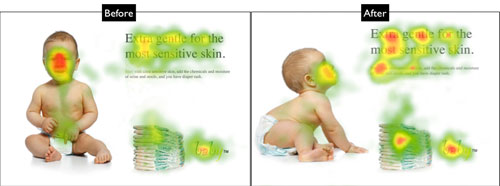Temporal Lobes, FFA, and Amygdala - oh my!
There is a special part of your brain (in the temporal lobe) specifically devoted to facial recognition*. That is how you're able to recognize the face of a friend (or foe) in a large crowd and, subsequently, react with the appropriate emotion - be it love, joy, fear, anger, etc.
The visual cortex is working overtime while looking at webpages, helping users form opinions of webpages in less than a second. As soon as a face is introduced to the webpage, the temporal lobe's fusiform face area (FFA) will kick in and speed up the process of helping users form opinions and direct attention. The temporal lobe is located close to the amygdala, the emotional center of the brain.
Eye Tracking, a Baby, and Your Users Focus
Take a look at the following heat maps, which show eye tracking of a test group of users:

Studies show faces looking right at the user have biggest emotional impact on a web page. It will also command the most attention.
If a face is looking at another spot on a page - an article or product - then the users will focus on that. You have less emotional impact doing this, but the attention gets drawn to content (which is ideal for landing pages).
Depending on your use case, you might consider using images of people in your web design. You obviously don't want to oversaturate your page with images of people, but used strategically you can increase the impact of your web pages.
*the exception to this rule is people with autism. A 2001 study by Karen Pierce shows that people with autism do not use the FFA, but their normal pathways in the visual cortex used for recognizing objects.
